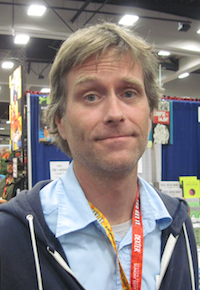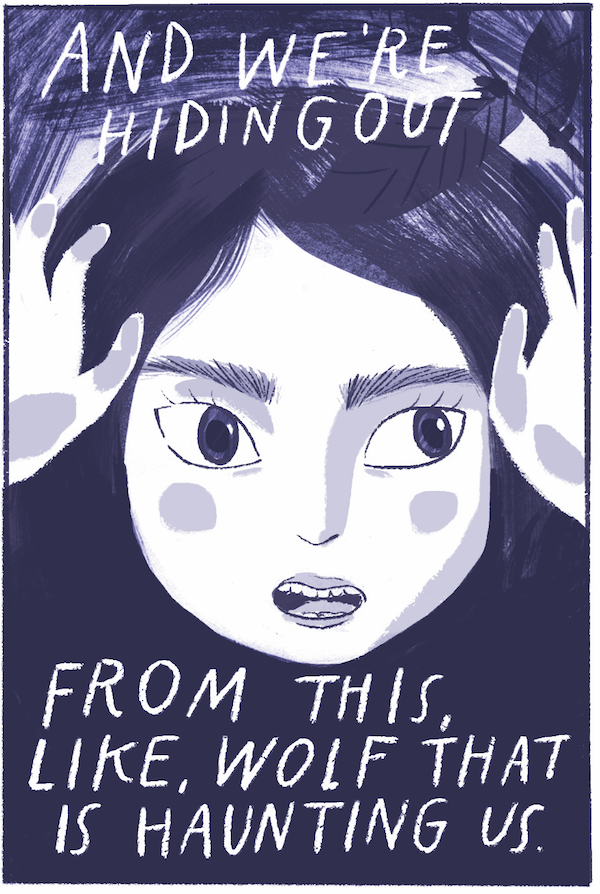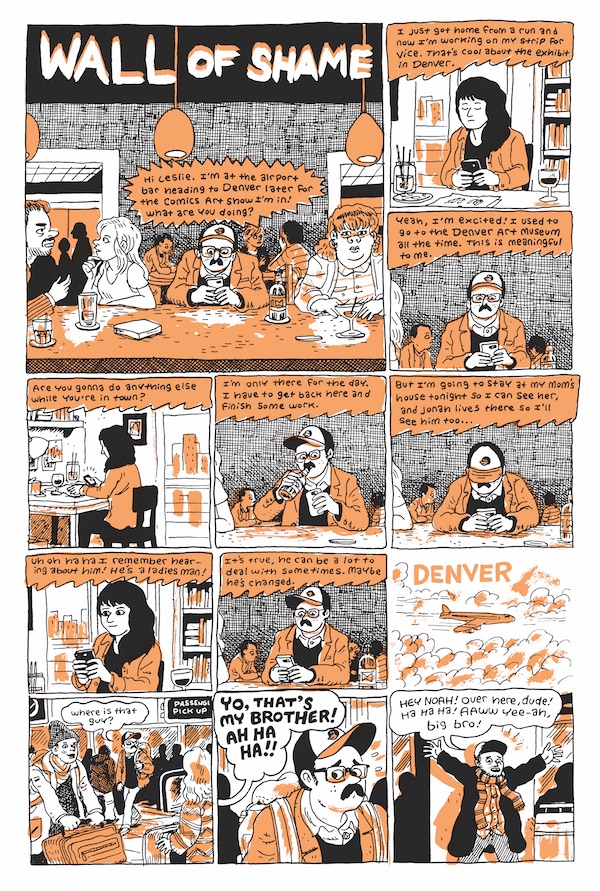 Home > CR Interviews
Home > CR Interviews CR Sunday Interview: Eric Reynolds
posted May 27, 2017
CR Sunday Interview: Eric Reynolds
posted May 27, 2017


One of the worst-kept secrets from
TCAF became wider news this weekend as
Fantagraphics Associate Publisher and longtime award-winning editor
Eric Reynolds has announced his return to alt-comics anthology-making, with the three-times-a-year
Now creeping into its book catalog listings. The first issue is touted as 128 pages with a $9.99 price tag. It will have an ISBN and thus be moved through book retail as well as Fanta's own store, its festival presence and through the Direct Market. It's full-color.

The volumes will feature stand-alone stories from what Fantagraphics PR calls "a diverse mix of emerging and established talent."
First issue line-up includes:
*
Gabrielle Bell
*
Sara Corbett
*
Antoine Cossé
*
Eleanor Davis
*
Kaela Graham
*
Sammy Harkham
*
Conxita Herrero
*
JC Menu
*
Rebecca Morgan (cover image above)
*
Tommi Parrish
*
Tobias Schalken
*
Dash Shaw
*
Daria Tessler
*
Noah Van Sciver
*
Malachi Ward
That's a heck of a first issue. Reynolds is an interesting editor for this anthology landscape as most of what's being done with a group release in mind is by young to very young cartoonists. Reynolds isn't of that world and I think as a result might be more rigorous in terms of which new cartoonists he finds specifically interesting. His work on
MOME was pretty great, and some of those cartoonists are here -- in a different place in their career, perhaps thanks in part to the opportunities created by their appearances in that anthology.
Now #1 is scheduled for September 2017.
*****
TOM SPURGEON: What made you decide to get back in? What about the comics world makes you want to take another shot at it?
ERIC REYNOLDS: It had been nagging at me for the past year. When
MOME ended, I felt like the landscape had changed and that there were more platforms than ever for cartoonists to get their work out there, and I felt good about ending it when I did. But somehow, over the past few years, I felt like the pendulum had swung back.
The idea really coalesced after last year's
Short Run festival. I went to that show with a plan to really canvas the show and see what was there. I don't get to actually shop extensively at shows very often, and I ended up dropping close to a couple of hundred bucks, buying anything that looked even remotely interesting. There was a lot of good work that I felt was probably being overlooked because of either the signal to noise ratio or even just the harsh realities of distribution. If you don't live in a region that has a show like Short Run, you're likely to never be exposed to a lot the work that's there. And I came away from that show realizing that Fantagraphics can provide a platform to get the work out there. Not in huge numbers, necessarily, but in a way that not everyone has access to, whether it's Diamond distribution to comic book stores, general trade bookstores,
Amazon, as well as digital platforms like Kindle,
Comixology, Google Play, etc.
Once I finally decided I had to do this, I just started sending out emails to cartoonists I admire, and the enthusiastic response -- my call for entries for the first issue yielded enough material for three issues -- has really buoyed me and made me think that this was very much a necessary thing right now.
Another reason was that there are just more good cartoonists out there right now than we could possibly offer book deals to. And, frankly, a lot of good cartoonists who might not be ready for a book deal yet, and just need some room to grow.
I guess I should also add that the election absolutely motivated me, too. I think I sent out my first "call for entries" within a day or two of the inauguration. I have no desire to make
Now overtly a political thing, but art is political, and it felt like something that I actually could do that would contribute to the greater good.
 SPURGEON: What made you decide to do this one solo? You did
SPURGEON: What made you decide to do this one solo? You did MOME
with Gary [Groth], although I'm sure his schedule meant only intermittent involvement. Did you consider a partner? What can you do as a solo act you maybe couldn't with a partner?
REYNOLDS: Oh, I don't know. I didn't decide to not have a partner,
per se. I just decided that this was what
I wanted to do.
I'm really not flying solo. Folks in the office, like
Jacq Cohen, Jason Miles,
Anna Pederson, and
RJ Casey have all been enthusiastically putting work under my nose. Several cartoonists have been great advocates for work that they think I should be paying closer attention to.
Jacob Covey is art directing and helping me create the best possible package. It's a team effort. When we started
MOME, the reason that Gary and I co-edited initially was because at the time, he and I were talking one day and I was telling him that I had an idea for an anthology, and in the course of doing so, it became clear that he had been ruminating on a very similar idea, so we just decided to do it together.
SPURGEON: What does right now in comics publishing demand from an anthology? What function does an anthology serve?
REYNOLDS: It depends on who it's serving; whether you're talking about the contributors, the booksellers, or the reader. I'm trying to serve all three of those bases.
A long of its function has to do with boosting that signal-to-noise ratio. It's routinely thrown out there that we live in a new golden age of comics, and I think that's really true. There's also this conventional wisdom that the entry point for a young cartoonist is easier than ever thanks to the internet, self-publishing, what have you, but I think that's only true up to a point, because bookselling in general continues to be consolidated into the hands of fewer entities, and I think we're in a better position to navigate that world than a lot of folks can on their own or with a micro-publisher -- no disrespect to the many excellent micro-publishers out there right now.
More to the point, I see the function of this anthology as being a outlet for cartoonists to experiment in a healthy way, and to gain experience in working for print in particular. It's also meant as an outlet for shorter work, specifically, which is something that I think has sometimes gone by the wayside in this whole graphic novel revolution of the past 15 or more years. For readers, it's intended to be an easy way to get exposed to as wide a variety of work out there without having to spend a fortune at a show like
SPX or Short Run, and to turn them on to an author's work.
I'm also making a concerted push to be as inclusive as possible and, frankly, broaden my own scope by pushing myself to seek out underrepresented voices. As you well know, we still operate in a field that is predominantly white and male. I feel a real responsibility to try to be a force for good on that front, in terms of diversity. Early on in this process, I had a conversation with Eleanor Davis that really cemented that for me. I'm aware that, to put it bluntly, I'm not getting any younger, and as you age it's all too easy to kind of settle into a comfortable groove in terms of the kind of art or entertainment you engage. So there's a little bit of me wanting to push myself and make sure I'm not getting too comfortable over here, and to try and be a force for good on that front by showcasing how much diversity is out there.
I also see this as an opportunity to publish more international cartoonists. There is so much good work going on internationally that I sometimes feel like I'm swimming in great looking foreign submissions. But translated books require so much more work and have a much higher overhead than books written in English, not just in terms of translation, but in terms of production and editing, as well, and we can only do a finite amount of these projects per year. This gives me the opportunity to take a chance on some cartoonists that I otherwise may not have a chance to work with.
 SPURGEON: Can you clarify your aspirations for this anthology in terms of what it does for the talent participating in it? I know last time you felt it important people have a place to publish that kept them working in an industry down-period.
SPURGEON: Can you clarify your aspirations for this anthology in terms of what it does for the talent participating in it? I know last time you felt it important people have a place to publish that kept them working in an industry down-period.
REYNOLDS: I hope it not only gives them a place to publish work that otherwise might not easily fit elsewhere, but also inspire them to do that kind of work, if that makes sense, and to expose their work to fresh eyes.
SPURGEON: The great anthology question: serials/no serials?
REYNOLDS: No serials.
SPURGEON: Whoa. [laughs] How'd you make that decision?
REYNOLDS: Serials wore me down in
MOME. Schedules get blown, and a three-chapter series ends up either being spread out over more than three issues, or balloons into more chapters than originally envisioned, or even gets abandoned before completion. I'm not pointing a finger at anyone -- it happens, and I just want to avoid it this time around. I suppose I could change my mind. More than anything, though, on a quarterly schedule, it just seems like a disservice to the reader. Serialization works better on at least a monthly or bimonthly schedule. I feel very strongly that I want each issue of
Now to satisfy on its own, with zero additional context or whatever.
*****
* cover by Rebecca Morgan for
Now #1
* photo of Eric Reynolds by Whit Spurgeon, early/mid 2010s
* images from #1 from Kaela Graham, Conxita Herrero and Noah Van Sciver [below]
*****

*****
*****


